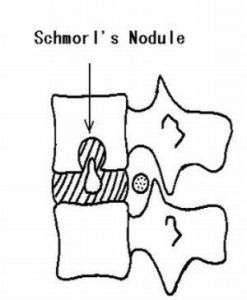

MedFriendly®


Schmorl's Nodule
To understand Schmorl's nodule (also known as Schmorl's
node), it is first necessary to understand some basic facts
about the spinal cord. The spinal cord is surrounded and
protected by bones known as vertebrae. The main part of
this bone is called the vertebral body. In between the
vertebrae are shock-absorbing disks. The soft, central part
of these disks is known as the nucleus pulposus. When a
disk breaks through one of the upper or lower parts of the
vertebral body, the soft central part of one of these disks
(the nucleus pulposus) can enter into it. When this
happens, it is known as a Schmorl's nodule.
FEATURED BOOK: Spinal Cord Injury: Functional Rehabilitation
Note that the circular area above should not be there. It is there because the disc broke
through the vertebral body, causing the nucleus pulposis to go into it.
WHAT CAUSES SCHMORL'S NODULES?
Schmorl's nodules tend to occur after trauma to the spine that causes wear and tear to it
over time. Usually, if repeated trauma caused the formation of Schmorl's nodule, the
patient does not remember a specific motion that caused the pain to begin. It may also be
possible that people can be born with Schmorl's nodules. Also, some people may be born
with weak bones that surround the spine, which makes it easier for the disk to enter the
bone.
"Where Medical Information is Easy to Understand"™
DO SCHMORL'S NODULES CAUSE PAIN?
Although Schmorl's nodules may cause pain (usually in the
middle/lower back), they usually do not cause any other symptoms
besides stiffness in the lower spine. In most cases, Schmorl's
nodes do not cause any symptoms at all. Since pain is a subjective
process, it can be experienced as mild, moderate, or severe. The
most common age group that present with pain due to Schmorl's
nodules are between 14 and 18. Such individuals usually play sports
and the pain prevents them from doing so any more, which causes
them to see a doctor. The area where the person feels pain is
almost always in the area where the Schmorl's nodule is located.
ARE SCHMORL'S NODULES RARE OR COMMON?
Schmorl's nodules are common and are mostly found in the middle and lower spine. They are especially
common when the spine has aged and undergoes minor degeneration.
WHAT SHOULD I BE CONCERNED ABOUT IF I HAVE SCHMORL'S NODULES?
It is generally accepted that the presence of one or many Schmorl's nodules can lead to earlier than
normal deterioration of the disks that are positioned between the bones surrounding the spine. This is
especially true in younger age groups.
HOW ARE SCHMORL'S NODULES DIAGNOSED?
Schmorl's nodules can be detected by an x-ray of the spine. However, a much more expensive test that
does not use x-rays, known as Magnetic Resonance Imaging, is better at diagnosing Schmorl's nodules.
HOW ARE SCHMORL'S NODULES TREATED?
Schmorl's nodules typically do not require extensive treatment. However, pain relief due to Schmorl's
nodules is usually relieved through rest and/or by going to a doctor who can use his/her hands to
manipulate the bones surrounding the spine. Doctors who do this are known as chiropractors. Surgery is
rarely used as a treatment for Schmorl's nodules if that is the only presenting problem.
WHY IS IT CALLED A SCHMORL'S NODULE?
Schmorl's nodule is named after Christian G. Schmorl (1861-1932), a German pathologist who first
described the condition in 1927. A pathologist is someone who interprets and diagnoses the changes
caused by disease in tissues and body fluids. Nodule comes from the Latin word "nodus" meaning "knot."















